88 years have gone past since 1935, but remnants of that time long gone can still be found today. If you found yourself a 1935 Buffalo nickel, you might be interested in how they have gone through all those years.
In this article, we will be talking about the value, varieties, history, grading, and errors that you might find on a 1935 Buffalo nickel.
1935 Buffalo Nickel Details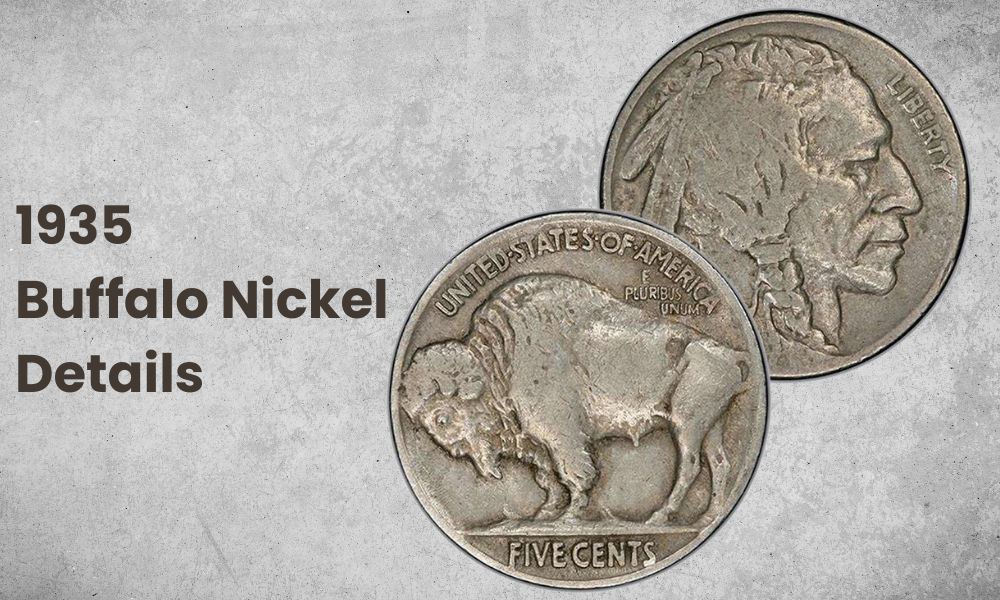
The 1935 Buffalo nickel is part of the series of coins called the Buffalo nickels, the five-cent coin minted from 1913 to 1938. It is named after the animal found on the reverse of the coin, which is technically a bison. It is also called the Indian Head nickel.
The 1935 issue started the high mintage of Buffalo nickels, up until its decommission in 1938. Among the 1935-1938 issues, the 1935 coins are the relatively rarer issues.
- Category: Buffalo Nickel
- Mints: Philadelphia, Denver, San Francisco
- Year: 1935
- Total Mintage: 80,656,000
- Obverse Designer: James Earle Fraser
- Reverse Designer: James Earle Fraser
- Edge: Plain
- Diameter: 21.2 millimeters (0.83 inches)
- Composition: 75% copper, 25% nickel
- Weight: 5 grams
Also Read: 15 Most Valuable Nickels Worth Money
1935 Buffalo Nickel Value Chart
| Mint Mark | Good (G-4) | Fine (VF-12) | Extremely Fine (XF-40) | Uncirculated (MS-63) |
| 1935 P (No Mint Mark) Buffalo Nickel Value | $1.13 | $2 | $3.30 | $51 |
| 1935 D Buffalo Nickel Value | $1.13 | $2.81 | $17 | $94 |
| 1935 S Buffalo Nickel Value | $1.13 | $2.28 | $4.52 | $79 |
1935 Buffalo Nickel Values and Varieties Guides
1935 P (No Mint Mark) Buffalo Nickel
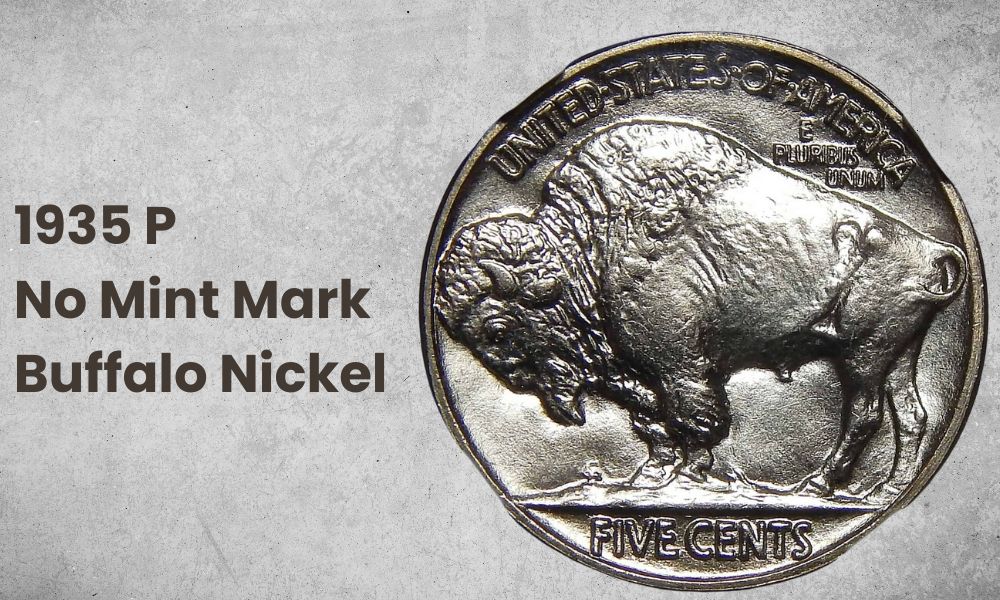
- Type: Buffalo Nickel
- Edge: Plain
- Mint mark: None
- Place of minting: Philadelphia
- Year of minting: 1935
- Face value: $0.05
- $ price: $1.13 to $31,500
- Quantity produced: 58,264,000
- Designer: James Earle Fraser
With over 58 million pieces minted, this year’s Philadelphia mintage joins the fray of the most common pieces in the Buffalo nickel series, together with the 1936 to 1938 issues. However, the 1935 issues are also not as common as the other years.
You can find these coins are plentiful across all grades up until MS66. Most specimens are well-struck, but some may not be fully struck at the center. It has a luster that is a cross between frosty and satiny.
Low-grade condition coins can come as low as $1.13 for a G4, while you can get them for up to $27 before you get the uncirculated coins. Uncirculated coins can go up to $120 for an MS64+, while the common coins can go as high as $250 for an MS66. Auctions for the highest grade for this coin, MS68, will net you around $31,500.
The current auction record price is $57,500 for an MS68 piece.
1935 D Buffalo Nickel
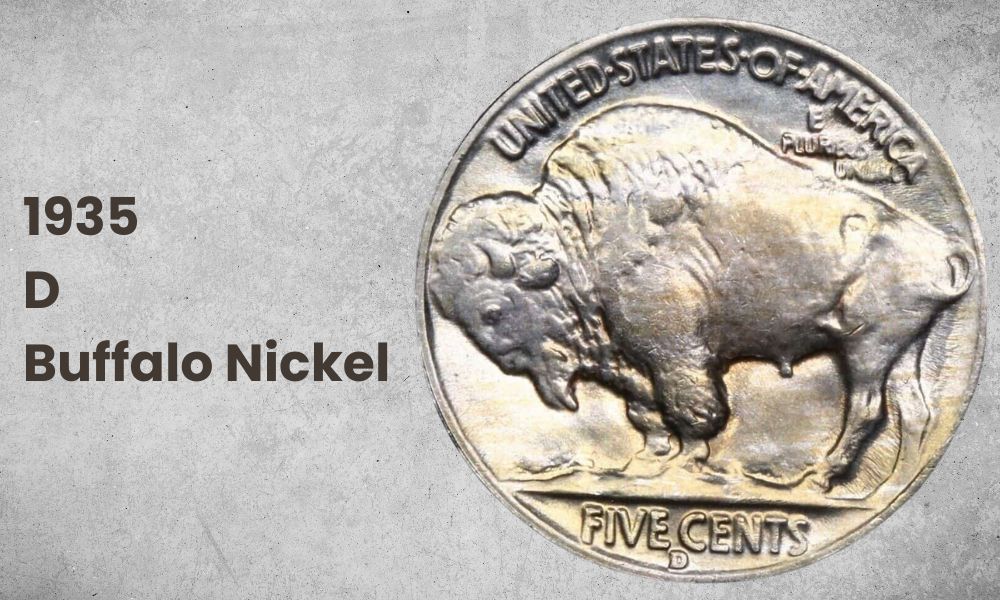
- Type: Buffalo Nickel
- Edge: Plain
- Mint mark: D
- Place of minting: Denver
- Year of minting: 1935
- Face value: $0.05
- $ price: $1.13 to $37,500
- Quantity produced: 12,092,000
- Designer: James Earle Fraser
Out of the 12 million pieces minted, less than 1% is estimated to have survived today, at around 15,000. Mint State coins may be plentiful, although gem examples get exceedingly rare. In fact, among the 1935 to 1938 issues, the 1935 D coins are the rarest in gem conditions.
Many coins from this mintage suffered from weak strikes, prominent on the horns on the reverse. The dies used for this issue were either very worn down or simply too far apart to fill the deeper cavities. Luster from the better coins is usually frosty, although you’re more likely to find them with deep furrows that do not flatteringly reflect light well.
Similar to Philadelphia coins, you’ll find the Denver coins for as low as $1.13, just a bit over their face value. Non-Mint State coins will cap out at $80, while uncirculated non-gem examples will cost you at most $225 for an MS64+ specimen. Gem examples, given their rarity, can easily go from $1,000 (MS66) to $37,500 (MS67+).
The current auction record is for an MS67+ specimen, sold at $34,800.
1935 S Buffalo Nickel
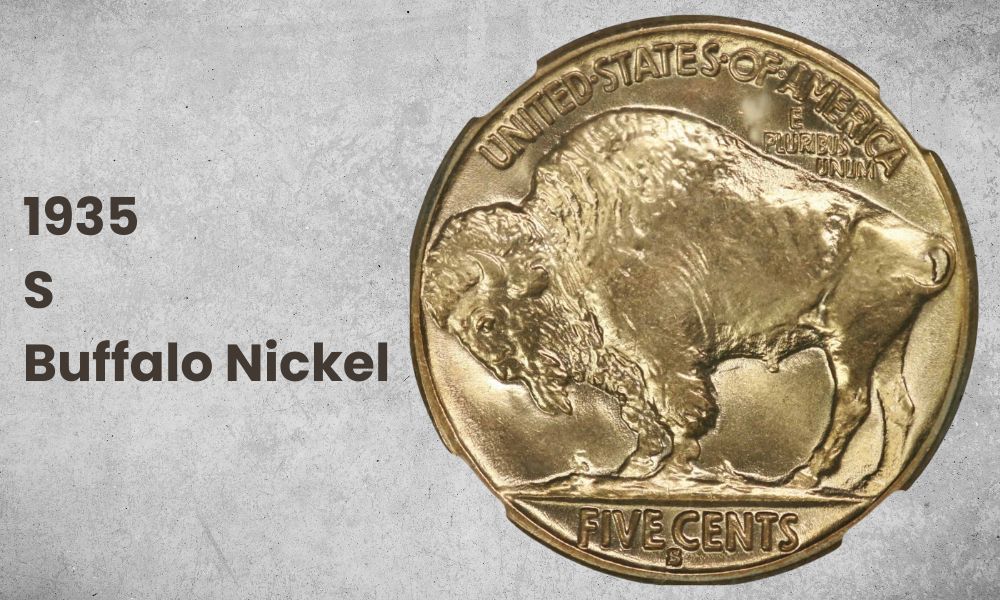
- Type: Buffalo Nickel
- Edge: Plain
- Mint mark: S
- Place of minting: San Francisco
- Year of minting: 1935
- Face value: $0.05
- $ price: $1.13 to $8,750
- Quantity produced: 10,300,000
- Designer: James Earle Fraser
This year’s issue from the San Francisco Mint is also the rarest among the supposed common dates 1935 to 1938. However, numerous rolls were also set aside by collectors at the time, so uncirculated grades are quite common for this coin.
Although their luster is pleasingly grey brilliant, their strike is not very good, and those with strong strikes would easily bring a premium. The sudden increase of coinage during 1935-1936 must have brought in an influx of new hires, hence there is quite a variety of errors present on this issue.
Like the rest of the 1935 coins, the 1935 S coins can be found for as low as $1.13, which increases up to $55 for circulated grades. Mint State coins can be found up to $600 for an MS66+ coin, while the highest grade, MS67+ can net you $8,750.
The current auction record price is $15,275 for an MS67+ coin.
Also Read: Top 110 Most Valuable Nickels Worth Money
1935 Buffalo Nickel History
The 1935 buffalo nickel is part of a series of coins called the Buffalo nickel, referring to the image of the buffalo impressed on the reverse of the coin. It can also be called the Indian Head nickel, referring to the Indian head impression on the obverse. The Buffalo nickel was struck from 1913 to 1938.
As part of a project to beautify the American coinage, then-President Theodore Roosevelt requested to update all coins as legally possible in 1904. To update the Liberty Head nickel, the Mint Director asked sculptor James Earle Fraser to produce sketches for coin designs.
Originally for a one-cent coin, Fraser’s design was used for the five-cent coin instead, which was due for a redesign by 1911. Mint Chief Engraver Charles Barber, who was the designer of the outgoing Liberty Head nickel, submitted his own designs for a Washington nickel, although it was rejected.
By 1912, news about the new coin design was spreading, and many coin-operated machine manufacturers were eager to hear about the details. Although Treasury Secretary Franklin MacVeigh assured that the physical dimensions of the nickel would not change, this did not satisfy the Hobbs Manufacturing Company.
The Hobbs Manufacturing Company claimed that they have a device that can detect counterfeit nickels, and thus they went into discussion with the artist, asking for modifications to the design. These discussions extended to late 1912 until the Treasury has instead passed the latest coin design without the company’s approval in 1913.
Later on, it was revealed that the devices did not work as well as the Hobbs Company claimed; one company was actually trying to decommission those devices since their performance was deemed “unsatisfactory.”
The coins were first distributed on February 22, 1913, during the groundbreaking ceremony of the National American Indian Memorial in Staten Island, New York. Forty coins were presented and given to the Native American chiefs. However, despite the ceremony, the National American Indian Memorial was never built.
Although the design was praised, the buffalo nickel proved difficult to coin. Within a week of production, the dies used to strike the coins were wearing out faster than usual. The coins were also not expected to survive ordinary wear and tear, especially the “FIVE CENTS” and the date.
Despite Fraser’s modification to the design, the coin still exhibited these problems. Hence, the Treasury was eager to replace the design. By the time the coin had reached the mandatory 25-year run, it was replaced by the Jefferson nickel.
Also Read: Top 19 Most Valuable Jefferson Nickels Worth Money
1935 Buffalo Nickel Grading
The Sheldon scale is a numerical scale from 1 to 70 used to assess the numismatic quality of a coin. The higher the grade, the better the quality. It also comes with qualitative descriptors, like Good, Fine, Almost Uncirculated, and Mint State.
Despite the Buffalo nickels being known to not have a good strike, there are good specimens around that may be worthy of a high grade if checked properly. Watch the YouTube video to see how to grade these Buffalo nickels.
Lists of 1935 Buffalo Nickel Error
Throughout the entire run of the Buffalo nickel series, it has been met with many problems in the Mint. Worn-out dies and weak strikes plague the nickel mintage. Here are some common errors that you might encounter when going through some 1935 coins.
1. 1935 Buffalo Nickel DDR and DDO
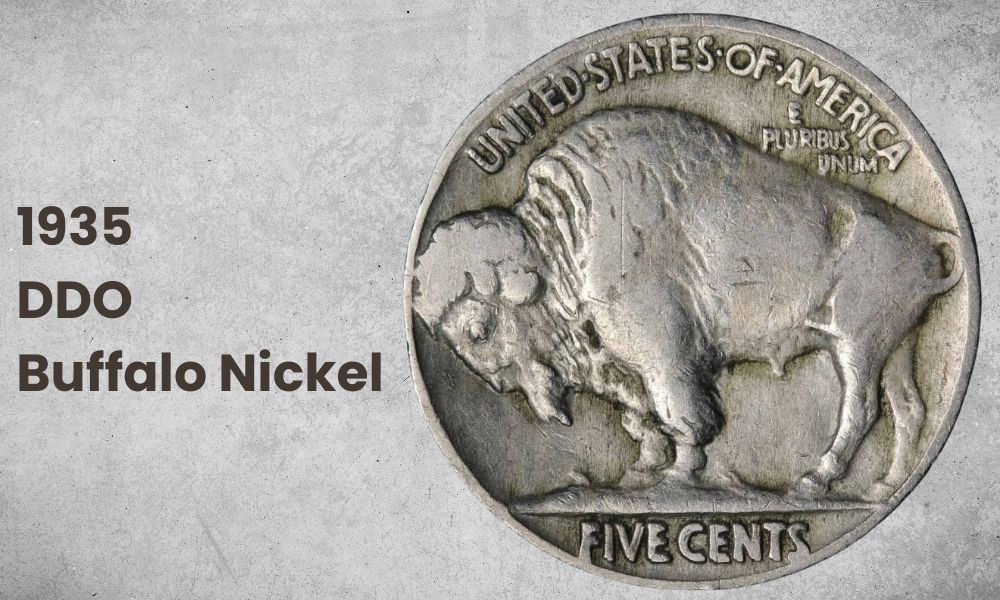
One of the most prominent errors in the 1935 issue is the doubled die error. This error is a manufacturing error on the die, where certain design elements are duplicated. The duplicate impression is slightly offset from the original one. Note that this error does not refer to a coin that was struck twice; the error is on the die that is used to strike the coin.
The error can be usually found on the “FIVE CENTS” for doubled die reverse (DDR) errors and occasionally on “LIBERTY” for doubled die obverse (DDO) errors. Philadelphia coins are rife with DDR coins, while San Francisco mintages can be found with both DDR and DDO coins.
The current auction record is a 1935 P MS65 DDR piece, which was sold for a whopping $104,650. Talk about an expensive coin!
2. 1935 Buffalo Nickel RPM
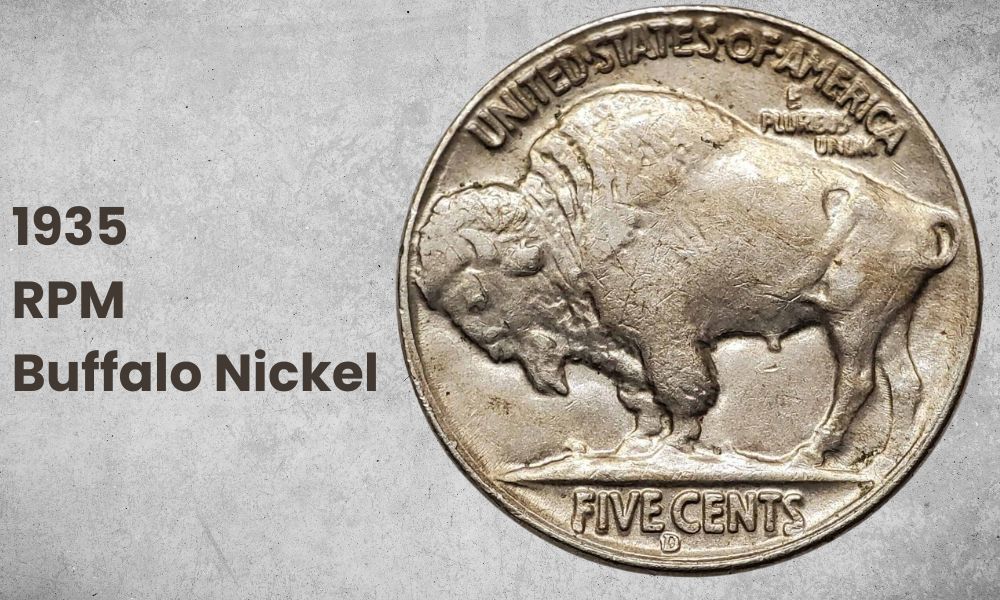
Another prominent error is the repunched mintmark error. This refers to a coin where the mintmark of the coin, found between “E” and “C”, contains a second impression of the mintmark. Unlike the doubled die errors where the coin die itself has the error, the repunched mintmark error involved a subsequent strike on the mintmark that offset from the original impression.
The RPM error is commonly found on the 1935 D nickels, where another D mintmark can be seen on top of the first mintmarks.
The current auction record price is $999 for a 1935 D nickel, graded XF40.
1935 Buffalo Nickel Value FAQs
What makes a 1935 Buffalo Nickel valuable?
The San Francisco nickels sport the lowest mintage, but it does not usually call for a high premium. Despite their low population, collectors were able to keep rolls of these coins in mint condition. Instead, the 1935 P and D have higher prices, especially on gem examples. In fact, a 1935 P coin with the DDR error was sold for over $100,000!
What is the error on a 1935 Buffalo Nickel?
There are two prominent errors that you might find on a 1935 Buffalo nickel. You might find a doubled die error on a 1935 P or S coin, while you might be able to spot a repunched mintmark on a 1935 D coin.
Are 1935 Buffalo nickels made of silver?
Unfortunately, the 1935 Buffalo nickels were not made of silver. They are made up of 75% copper and 25% nickel. Nickels, or all five-cent coins minted ever since have not been made of silver, except the Wartime Nickels, which contained 35% silver.
How many types of Buffalo nickels are there?
There are two main types of Buffalo nickels: Type I and Type II. When the original design was cropping up some problems for the Mint, the designer was asked to make another design to help alleviate those problems, although it ended up causing more problems instead.
Type I is the first type to be coined, which was the original design minted in 1913. In this type, the buffalo on the reverse is standing on raised ground. Once the Chief Engraver realized the problems with the dies, he then asked the designer to modify the design right away.
Type II is the second type to be coined. Type II was coined in 1913, right when they retired Type I. In this type, the buffalo is standing on recessed ground instead. Unfortunately, the problems were exacerbated with this design. Regardless, most Buffalo nickels, including the 1935 issue, are made with the Type II design.
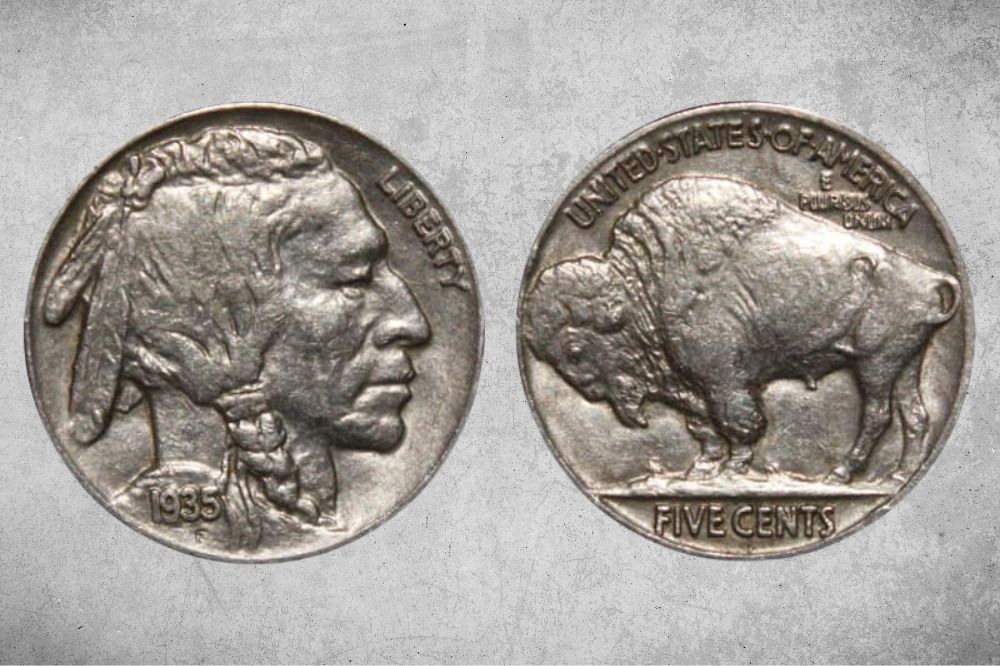
En Cuba, con el triunfo del nuevo gobierno de 1959, salieron de circulación todas las monedas norteamericanas y quedaron ociosas guardadas en cajones.O sea, esas monedas llevan más de 60 años sin circular y la mayoría están con alto grado de conservación.Yo tengo un Indio Búfalo de 1935 y le quité lo sucio con la llema de mis dedos húmedos con agua y jabón y adquirió un brillo que no ha perdido jamás.Yo considero que debe estar en MS 66 o 67. ¿ Hice mal al limpiarlo con agua y jabón?